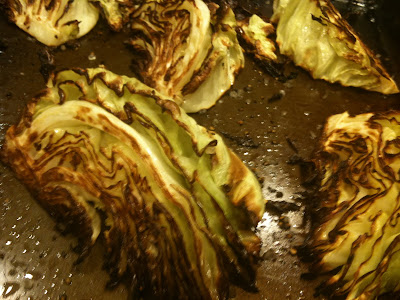So, last week we talked about quick, assembly-only "food on bread" dinners -- basically, sandwiches and quesadillas. This week, in the second half of January's installment in
our year-long Learn to Cook series, we're going to talk salad days. I eat a lot of salad, often at lunch. But I love a "
big salad" (a la Elaine) for dinner, especially on warm days or on days when I've had a bigger-than-usual lunch. But best of all, salad is an assembly-only meal that is light, refreshing, nutritious, and satisfying. So it's perfect for the new cook.
The difference between a ho-hum salad and a memorable, craving-inducing salad really comes down to the dressing. So let's establish this straight away: bottled dressings simply aren't as good as homemade ones. If you have nice, tender greens and interesting, flavorful mix-ins, don't drown them in a thick, sugary, bottled dressing. What's the point? Instead, highlight them with a simple vinaigrette or, my personal favorite, a lemon-oil dressing (see below).
So, let's build a better salad.
Step #1: Choose your greens.
I like baby greens for almost every salad. The only exception is when I want a lot of crunch, to stand up to heavy mix-ins. Then, I go for romaine. If you have access to super-fresh greens from a farmer's market, that is the way to go. But those bagged, grocery store mixes are a good runner-up.
Once you gently wash your greens, spin them dry in a salad spinner. You don't want water-logged greens, so dry them well. Put them into a big bowl, so that you'll be able to toss them well. Then, I like to salt and pepper my greens, rather than putting salt into the dressings.
Step #2: Choose your mix-ins.
Unless I'm going for a particular genre (see below!), then I follow a basic formula when assembling a salad: sweet + savory = one tasty salad. The classic example here is a spinach salad with pears (sweet), walnuts (savory), and blue cheese (savory). Another favorite of mine is beets (sweet), walnuts (savory), and crumbled goat cheese (savory). (If you have a little fresh dill to put on that one, it's divine!) And when the tomato days hit in summer, try a mix of heirloom tomatoes with goat cheese and basil. So yum.
To add some heft to a dinner salad, add a meat (savory). Later on this year, when you're really cooking, you'll likely have lots of leftovers to choose from (grilled chicken, roasted turkey, etc.). But for now, consider buying a roasted chicken from the grocery store.
Other interesting mix-in ideas:
Sweet:
Apples
Pomegranate seeds (I can buy the seeds by themselves at my farmer's market and at my grocery store)
Beets (I
roast them, but, beginners, try canned!)
Citrus sections (clementines, grapefruits, oranges, etc.)
Grapes
Berries
Dried fruit (cranberries, apricots, raisins)
Tomatoes
Savory:
Avocados (great mixed with the grapefuit sections!)
Meats (leftover chicken, turkey, beef, or pork, or chicken from a grocery-store roasted chicken)
Salmon -- smoked or canned
Tuna
Bacon
Hard-boiled eggs
Onions
Roasted potatoes or other veggies
Blue cheese
Feta cheese
Goat cheese
Fresh mozzarella
Shavings of Pecorino Romano or Parmegiano Reggiano
Nuts (hazelnuts, walnuts, almonds, pine nuts)
One other mix-in idea that I have to mention, but that steps outside of my usual sweet + savory formula, is the mixed-herb salad. Chop a variety of fresh herbs -- basil, parsley, chives, tarragon, etc. -- and toss them with your greens. So, so good.
One note: With the exception of the mixed herbs, don't add your mix-ins to your salad until AFTER you dress the greens.
Step #3: Choose your dressing.
I have three basic dressings that I use for nearly every salad. As noted above, I salt my greens directly, so you won't see "salt and pepper" on the ingredient lists for these dressings. Feel free to add your salt and pepper to the dressings, instead, if you like. Also, I mix all my dressings in a little glass jar with a tightly fitting, screwtop lid. If you don't have a jar, you could whisk the dressings together in a small bowl. (But find yourself a little jar! Really, it's quicker and, if you have leftover dressing, you can store it right in the jar you mixed it in.)
Basic Vinaigrette (adapted from Julia Child and Jacques Pepin,
Julia and Jacques Cooking at Home): Finely chop some garlic until you have about 1 tsp. Add 1 TBSP Dijon mustard, 2 TBSP red wine vinegar, and 1/2 c olive oil. Shake it up. Taste and add more acid (vinegar) or oil, as you like. Store in fridge up to 2 weeks -- just shake to re-blend before using. If garlic isn't your thing, try grating a bit of shallot or onion. (I use more than 1 tsp. when I use a shallot.) Also, if you are really pressed for time, just skip the garlic/shallot. It's still good.
Lemon-Oil Vinaigrette (adapted from Julia Child and Jacques Pepin,
Julia and Jacques Cooking at Home): If vinegar is a little too much acid for you, try this more delicate lemon juice-based dressing. Mince or grate some shallots until you have about 1 TBSP. Add 2 tsp Dijon mustard, 2 TBSP freshly squeezed lemon juice, and 1/2 cup olive oil. Shake until emulsified. Taste.
Walnut-Oil Vinaigrette (from the back of a bottle of walnut oil!): 4 TBSP walnut oil, 1 TBSP balsamic vinegar, 1 tsp Dijon. Shake. Serve with salads in which walnuts are a "savory" ingredient. If the dressing tastes too strongly "nutty" to you, try it with half walnut oil and half canola oil. I've also made this with hazelnut oil and it was great. It's a nice change of pace from regular vinaigrettes.
Add the dressing to your greens in small amounts -- start with just a TBSP or two. Toss it gently with tongs. Taste a leaf and add more dressing if needed. Ideally, there should never be a pool of dressing at the bottom of your salad bowl. The greens should just be glistening, lightly covered with dressing.
*Extra Credit: Take Your Salad On a World Tour.
When you're ready to venture beyond the sweet/savory formula, pick your favorite type of ethnic food and try to construct a salad out of the basic flavors of that cuisine. A few examples:
Japanese: (adapted from Rachel Ray,
30-Minute Get Real Meals) The real star here is the dressing, a ginger-soy vinaigrette: juice of 1 lime, generous 1 tsp Dijon mustard, 1 TBSP tamari (or soy sauce), 1 tsp ginger (bottled or grated fresh). This is fabulous just on plain baby spinach. If you have warm grilled chicken or portabella mushrooms, and a few TBSP of toasted sesame seeds, add any or all of them. (Warm chicken or mushrooms will wilt the spinach a bit, and it's delicious! Also, toasted sesame seeds are available in the Asian foods aisle.)
Greek: (adapted from Rachel Ray,
30-Minute Get Real Meals) This is the classic greek salad: chopped tomatoes, cucumbers, and feta cheese. No lettuce! Dress with the juice of 1 lemon, a drop or two of hot sauce, 4 tsp olive oil and sea salt. Want to take it up a notch? Add red onion, kalamata olives, and/or a few peperoncini. Top with chicken or maybe even grilled shrimp or sauteed scallops. If you want to serve it over greens, go with romaine. Note: wait til summer for this one! The tomatoes are the main attraction here, and they won't be worth it until summer.
Italian: (adapted from Rachel Ray,
30-Minute Get Real Meals) Everyone loves an antipasto salad at a pizzeria, right? Well, it makes a great meal on its own, too. Romaine lettuce, artichoke hearts, bottled roasted red bell peppers, peperoncini, kalamata (or other good quality olives), Genoa salami, provolone cheese, fresh mozzarella cheese, tomatoes. Dress greens with about 1 TBSP red wine vinegar and about 2 TBSP olive oil. Top with fresh basil.
Mexican: When you are craving Mexican food, but don't want something heavy with meat and cheese, a taco salad is a great choice. I often serve a small version of this salad with the
quesadillas I discussed last week. Romaine or even shredded iceberg, black beans (or kidney or pinto), avocado, shredded Mexican-blend cheese, fresh cilantro, a little lime juice, and/or tomatoes. Use your favorite salsa for dressing. If you are ready for a little more cooking, serve with
roasted corn added in. As you can see from the photo, I have a bit of an obsession with the roasted corn . . .
Enjoy! Sorry there aren't more photos . . . it's been raining cats and dogs all week, so I haven't been a salad mood!
M
















